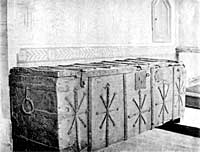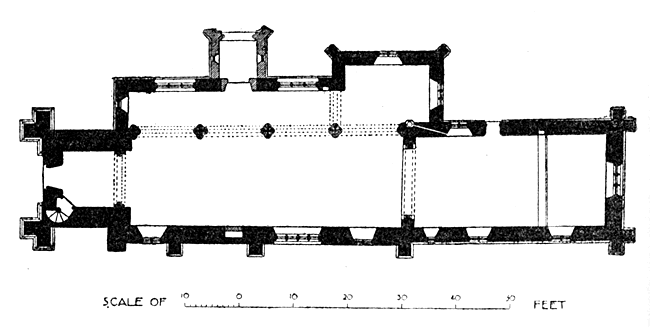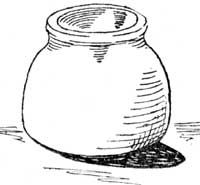
Upton Church — the church chest.
A portion of the rood-screen remained in situ until fifty years ago, when it was taken down and destroyed. The present chancel arch is said to have been re-built exactly on original lines, but there seems to be some confusion here, and the statement must be accepted with reserve. At any rate the work does not compare favourably with the tower arch, which is obviously old work, and to which the remark would well apply.
When the south wall of the nave was taken down and re-built in 1863, the old window dressings and other worked stones (with the exception of the south entrance) were re-fixed as nearly as possible in their original position. The sun-dial which formerly stood in the wall above the now discarded entrance has been preserved and will shortly be re-fixed; but it is to be noticed that there is now no entrance door at all on the south side of the church (see plan).
The whole of the south wall of the chancel, and portions of the east and north walls have also been re-built: the contrast between the old rubble walling, and the newer ashlar of Maplebeck stone may be clearly seen on the exterior. Portions of the square headed Decorated window tracery, of the familiar Nottinghamshire type, and the carved brackets on either side of the east window, are the original work of the 14th century. It is possible that these brackets once carried images of St. Peter and St. Paul, for this, according to York Records was the early dedication. The village feast is celebrated on June 29th—St. Peter’s day, and the church is now styled St. Peter’s.

Plan of Upton church.
The aumbry in the north wall is made up of fragments of early incised grave covers. A calvary, with the stem and portions of a foliated cross may be distinctly seen when the door is open. When the chancel was taken down (in 1863) “six rude earthenware pots were found embedded in the walls of the old structure of the Decorated period. These were placed three on each side at intervals of six feet, and seven or eight feet above the floor, with their mouths facing outwardly but covered with plaster.”1 Whether the early builders succeeded in bettering the acoustic properties of churches in this way is a moot point, but it is certain that both in England and on the Continent, the custom was extensively adopted, beginning in the 11th century and extending well on into the 17th century. Anyway, the discovery was an interesting one, and it is to be regretted that only the broken fragments of one of these jars can now be found . It measures ten inches in diameter, ten inches high, and is a quarter of an inch thick, and is made of dark grey earthen-ware having a semi-glazed surface, pale red in colour, both and out.

It will be noticed, that in common with many other churches, the axis of this chancel is deflected a little toward It has been said that this was intended to symbolize the drooping of the Saviour’s head when on the cross; and it is urged in support of the theory, that in a simple plan like this, having a continuous wall on one side from east to west to form a base line, it speaks but ill for the mediaeval craftsman if the deflection was the result of carelessness or miscalculation on his part, when setting out the building. But we must bear in mind that the old chancel (prior to the restoration of 1863) was a new chancel in comparison with the original nave, and who can tell what difficulties may have beset the path of the 14th century builders. They would certainly make their chancel longer, if not wider than the old one, and a portion of the new walls would be built before the old walls were taken down. In my opinion, this would be quite sufficient to account for the divergence. But another reason has occurred to me while studying the plan of this church—a reason hitherto overlooked. I am inclined to think that the squint and the deflected axis have a distinct bearing the one on the other. In this case a direct line of sight was only made possible by slewing the chancel to meet it. I am assuming that this squint was made to enable an attendant, stationed by the old north porch—or perhaps in a chamber over it—to see the server at both altars, and to ring the sacring bell which hung in a cote on the parapet of the original porch, (the squint is too narrow and too high up above the floor to have served any other purpose.) Unless the divergence is very pronounced,—when it becomes distortion—this peculiarity in the plan of a church will be apparent to only one person out of every hundred who enter its doors; if it is only slight, as in this case, it passes unnoticed unless attention is called to it: and while I am aware that some modern churches have been built with this idea, I question whether such subtle symbolism would appeal to the mind of mediaeval builders, and we must therefore look for a practical solution of this question.
Prior to the restoration there was a musicians’ gallery at the west end of the church; the lancet window at the end of the aisle, which is older than the wall in which it is fixed, was placed there to light it. We can forgive the restorers for removing the gallery, but it is deplorable to state that the ancient font was ejected at the same time, and in its stead a very inconvenient modern production was placed in a very inconvenient position. The ancient font—which was made out of a Decorated capital and shaft—after serving for a time as a flower vase in a garden, and later, in the churchyard,2 has eventually been brought into the church again. It is to be hoped that ere long it will be fixed at the west end of the aisle, and restored to its proper dignity.
A prominent feature of this church is the fine 15th century tower at the west end of the nave. It rises in three stages with heavy right-angle buttresses at the western corners and similar buttresses irregularly placed on either side. There is a western doorway in the lower stage with a good Perpendicular window above it. The middle stage is pierced with small plain openings, which are scarcely noticeable: the upper stage has an imposing three light louvred opening on each side and a grinning gargoyle to carry the water from the roof, immediately above the crown of the arch. The embattled parapet is crowned with panelled and crocketted pinnacles, which form a conspicuous feature in the landscape.
(1) Archdeacon Trollope, 1871.
(2) In the illustration of the tower, the font may be seen standing by
the west door.
